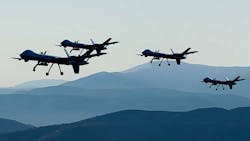Military researchers ask industry for autonomous vehicle swarms technology with trusted computing built-in
ARLINGTON, Va. – U.S. military researchers are asking industry to develop distributed, secure, and trusted-computing for heterogeneous swarms of autonomous vehicles.
Officials of the U.S. Defense Advanced Research Projects Agency (DARPA) in Arlington, Va., issued an SBIR/STTR Opportunity (SBO) Monday for the Distributed, Secure, and Trusted Processing for Heterogeneous Swarms of Autonomous Vehicles project.
The project seeks to develop a powerful, scalable distributed computer and software development environment that enables secure and trusted collaboration and processing across a heterogeneous mix of autonomous vehicles on low size, weight, and power, and cost (SWAP-C) commercial off-the-shelf (COTS) computer hardware.
There has been significant growth in autonomous vehicles and the proliferation of low-cost sensors and other internet of things (IoT) technologies, DARPA officials point out, yet few are designed with cyber security in mind.
Although U.S. military is taking advantage of these technology advances to create new and potentially game-changing military capabilities, these technological advances also introduce new attack vectors for adversaries to exploit.
DARPA is looking for methods to ensure that trust and security are designed into all aspects of the autonomous capabilities to include the platform, platform autonomy, sensors, computer processing, and communications to ensure warfighters trust the technologies.
The Distributed, Secure, and Trusted Processing for Heterogeneous Swarms of Autonomous Vehicles project seeks to create a distributed, secure, and trusted processing environment for heterogeneous swarms of autonomous vehicles that makes the most of flexibility while guaranteeing computational assurance and trust in each node of a swarm.
This environment could be a combination of several techniques, coupled with formal verification, and a disciplined language for secure and trusted computing. The development language should enable rapid implementation of new missions and swarm tactics while significantly reducing the risk of introducing vulnerabilities.
The solution should address the encryption and authentication of all traffic among nodes by capitalizing on commercial encryption approaches. It should provide lightweight, mesh-network protocols with minimal overhead to reduce detectability, and defend against protocol-based attacks.
It should use open-communications protocols, but ensure that they are reliable in an intermittent communication environment and against protocol-based attacks. It should require tools that help the developer adhere to best practice for creating secure and trusted autonomy applications that capitalize on a distributed processing environment.
The environment and the language should accept new sensors, effectors, processors, and autonomous flight algorithms with minimal effort. The language should be open and easily incorporated into higher-level software tools. Autonomous vehicles in a heterogeneous swarm should be able to monitor each other for anomalous behaviors, and detect discrepancies that may not be detectable from one platform.
This project is accepting direct to phase-two proposals only. Proposers must demonstrate in-depth knowledge of secure and trusted embedded processing as it relates to IoT and autonomous vehicles. For this BAA, IoT is the extension of internet connectivity into physical devices and everyday objects.
Related: DARPA seeks to develop ways to swarm unmanned vehicles for better military reconnaissance
When embedded with electronics, internet connectivity, and sensors, these devices can communicate and interact with other devices over the internet and can be monitored and controlled remotely.
Proposers should provide security and trust architecture design documentation with formal-method proofs of security, published papers in referred journals, detailed descriptions of prototypes with supporting security analysis, or similar evidence of a track record of developing secure and trusted embedded computing technologies for IoT or autonomous vehicles.
Companies interested should submit full proposals no later than 15 Nov. 2019 to the DoD SBIR/STTR Proposal Submission website at https://sbir.defensebusiness.org. Email questions or concerns to [email protected], with BAA number HR001119S0035-20 in the subject line.
More information is online at https://www.fbo.gov/spg/ODA/DARPA/CMO/HR001119S0035-20/listing.html.
About the Author
John Keller
Editor-in-Chief
John Keller is the Editor-in-Chief, Military & Aerospace Electronics Magazine--provides extensive coverage and analysis of enabling electronics and optoelectronic technologies in military, space and commercial aviation applications. John has been a member of the Military & Aerospace Electronics staff since 1989 and chief editor since 1995.
